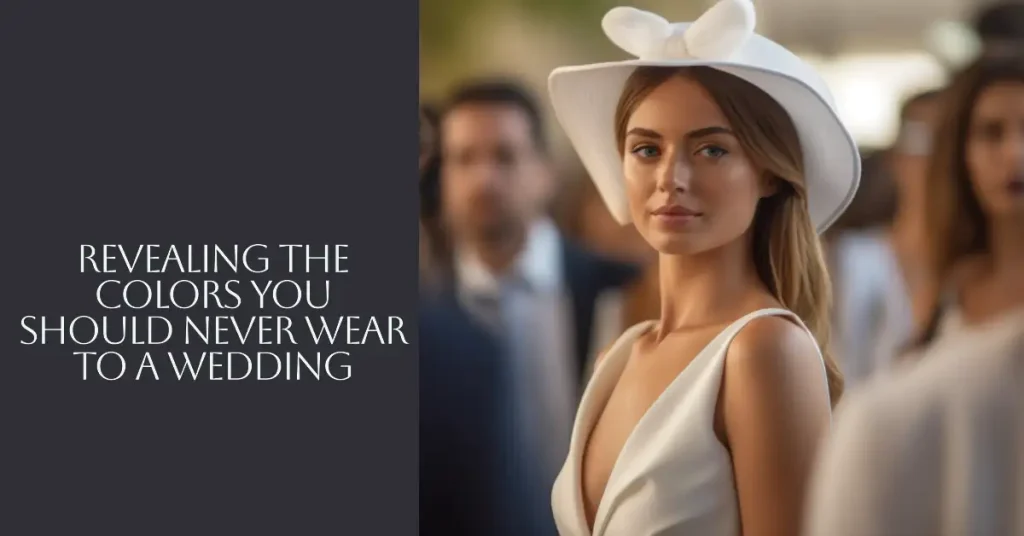Table of Contents
Wearing white to a wedding is generally considered inappropriate because it can overshadow the bride, who traditionally wears white. It’s a gesture of respect and etiquette to avoid wearing white in order to let the bride shine on her special day.
We’ll discuss this topic in more detail in the paragraphs below…
Have you ever received an invitation to a wedding and immediately thought, “What am I going to wear?” We all have, haven’t we? Now, imagine you’ve picked out the perfect white outfit only to discover an unwritten rule: you can’t wear white to a wedding. This article will shed light on why this tradition exists, how it has evolved, and everything else you’ve ever wondered about it.
- Carter, Lisa (Author)
- English (Publication Language)
- 107 Pages - 04/06/2024 (Publication Date) - Independently published (Publisher)
Historical Context
Stepping Back in Time
Let’s embark on a journey to the heart of the 19th century, an era defined by major social and cultural transformations. One such change was initiated by Queen Victoria, a true trendsetter of her time.
The Victorian Influence
In 1840, Queen Victoria chose to wear a white wedding gown when she married Prince Albert. Prior to this, brides simply wore their best dress, irrespective of its color. Victoria’s decision was a deviation from the norm and set a new precedent. She chose white not to symbolize purity, but rather to best showcase the lace on her gown – a fine example of personal style becoming a universal trend.
The Ripple Effect
The choice of Queen Victoria’s white wedding gown was widely publicized, leading to an increased desire amongst brides-to-be to mimic this royal fashion. Soon, the color white in wedding attire started to become synonymous with the bride. Ladies’ magazines of the time began to uphold this trend, further cementing the association of white with bridal gowns.
White as the Bridal Standard
This influence has persisted and even strengthened over time. By the end of the Victorian era, the white wedding dress had become a symbol of the bride herself – a statement of her joy, commitment, and the promise of a new beginning. Even today, many brides opt for a white gown, a testament to the enduring influence of Queen Victoria’s style choice.
The Significance of the Color White in Weddings
The Power of Color
Color plays a vital role in our lives, doesn’t it? It sets the mood, evokes emotion, and even carries symbolic meanings. Among them, white holds a special place. But what makes white so unique, especially in the context of weddings?
White Across Cultures
In various cultures worldwide, white carries symbolic connotations of purity, innocence, and new beginnings. For example, in Western cultures, white is often associated with innocence and purity, while in Eastern cultures, it can symbolize spiritual awakening and peace. These profound associations make it a meaningful choice for a day as significant as a wedding.
The Choice of Brides
Given these symbolic undertones, it’s no surprise that white became a fitting choice for the blushing bride on her wedding day. It’s not just about following a trend or fashion; it’s about the bride aligning herself with the ideals that the color white embodies – purity, unity, and the promise of a fresh start.
An Enduring Tradition
Over time, the white wedding dress has become deeply embedded in western wedding traditions. So deeply, in fact, that it’s hard to imagine a traditional western wedding without picturing the bride in a stunning white gown. This tradition is a beautiful way of visually and symbolically highlighting the bride’s journey into a new phase of life.

The Bride’s Spotlight
Stepping on Stage
You’ve practiced and prepared for your moment in the spotlight. As the curtain rises and you’re about to begin your solo, someone else steps onto the stage with you. Can you feel the confusion, maybe even a touch of disappointment? That’s how a bride might feel when a guest arrives in white at her wedding.
Sharing or Overshadowing?
It’s a widely held belief in many cultures that a wedding is primarily the bride’s day. After months, sometimes years of planning, she’s the leading lady in this particular show. Just as you wouldn’t want to share your well-rehearsed solo, you wouldn’t want to inadvertently steal her limelight. Wearing white as a guest can detract from her special moment, and that’s a faux pas worth avoiding.
Celebrating Love and Commitment
A wedding is a celebration of love and commitment. It’s a unique and precious day where the couple shares their promise of unity with their loved ones. The bride, often in white, stands as a symbol of this promise. She deserves to shine on her big day, don’t you think?
Maintaining the Wedding Etiquette
Understanding and respecting this etiquette is a sign of care for the bride and groom. It shows that you respect their choices and that you’re there to support and celebrate their love, not to distract from it. In essence, it’s a simple act of kindness and consideration that can go a long way.
Modern Views and Variations
Flexibility in Tradition
As much as traditions provide us with a sense of continuity and shared history, they aren’t set in stone. They evolve with time, adapting to changing views, tastes, and societal norms. The “no white” rule at weddings is no exception to this.
The Modern Twist
In recent years, some couples have put a modern twist on this long-standing tradition. They’ve invited guests to wear white, turning the traditional ‘no-no’ into a unique style statement. This is often done to create a monochromatic theme or a unified aesthetic for the wedding, demonstrating how creativity can bend even the most traditional rules.
A Case in Point: Solange Knowles’ Wedding
Consider the all-white wedding of Solange Knowles. She encouraged all her guests to wear shades of white, creating a visually stunning, monochromatic ensemble. It was a bold move, but it showed how a departure from tradition could be embraced and celebrated. Her wedding photos, awash in white, created quite a stir in the media and left an indelible impression in the world of wedding fashion.
It’s All About Personal Choices
While the tradition of the bride wearing white remains strong, these modern variations remind us that ultimately, a wedding is about the couple’s personal choices. It’s their day to express their love in a way that resonates with their own tastes and values.
Alternatives to Wearing White
Broadening the Color Palette
Are you used to reaching for white when dressing for special occasions? Don’t worry if you’re feeling a little lost without your trusty white ensemble. When it comes to wedding guest attire, the world of color is your oyster.

Seasonal Suggestions
Consider the season when you’re choosing your outfit. Attending a spring wedding? Why not choose a pastel-colored outfit? Soft pinks, lilacs, and baby blues capture the fresh, blossoming vibe of the season perfectly. For a summer wedding, you might choose bright, lively colors to match the energetic atmosphere. As autumn rolls around, you can echo the richness of the season with deep reds, oranges, or golds. Winter ceremonies often pair well with jewel tones – imagine a deep sapphire blue or a vibrant emerald green.
Style and Respect in Harmony
The options are truly limitless, and this is your chance to express your unique style. Whether you prefer bold patterns, classic cuts, or avant-garde designs, there’s a way to make a stylish statement while also being respectful of wedding etiquette.
Function and Venue Considerations
Don’t forget to consider the function and venue. A beach wedding might call for light, flowing fabrics, while a black-tie affair could provide an opportunity to don that glamorous evening gown. Remember, your attire isn’t just a reflection of your style; it’s also a nod to the couple’s chosen theme and setting.
Bridging Tradition and Personal Choice
Navigating the Spectrum
Weddings are indeed a beautiful blend of age-old traditions and personal touches. As a guest, navigating this spectrum of tradition and individuality can be a bit tricky, especially when it comes to your outfit. While it’s important to showcase your individual style, it’s just as essential to balance this with the traditions and customs that the couple holds dear.
Balancing Act
Think of your wedding outfit as a balancing act. On one side, there’s your personal style, the unique fashion statement that sets you apart. On the other side, there’s respect for tradition, an understanding and acknowledgment of the cultural and personal significance of the event.
The Art of Consideration
Choosing what to wear to a wedding is, in essence, an art of consideration. It’s about making a thoughtful choice that communicates your respect for the couple’s special day. It’s about being mindful of their traditions and customs, understanding the unspoken rules, and incorporating all these aspects into your attire.
A Reflective Decision
Your outfit should reflect not just your personal style, but also your respect for the couple’s choices. It’s a way of saying, ‘I am here to celebrate your love and commitment, and I honor the traditions that you hold dear’. It’s a simple yet profound way to show your support and contribute to the joyous atmosphere.
The Final Word: Respect and Celebration
At the end of the day, the golden rule of wedding etiquette – and indeed, all etiquette – is simple: respect the couple’s wishes. Weddings are a unique celebration, an amalgamation of love, commitment, and unity. Each decision, including the unwritten ‘no white’ rule, is part of the tapestry that makes up this joyous occasion.
Your attire as a guest plays a role in this celebration. By choosing your outfit wisely, you’re not just showing up in style, you’re also acknowledging and respecting the couple’s preferences and the sanctity of their love story. This, in itself, is a celebration, a silent toast to their journey together.
So, as we navigate through the exciting world of wedding traditions and attire, let’s remember to focus on the heart of the matter – celebrating the couple’s love story. It’s their day, their moment. Our role as guests is to contribute to the joy and unity of the day.
Whether you’re donning a pastel summer dress, a bold autumn suit, or a chic monochromatic ensemble specifically requested by the couple, do so with joy and consideration. Know that your choices contribute to the atmosphere of the day, adding to the vibrancy, unity, and love that makes a wedding truly special.
Conclusion
So there you have it. Wearing white to a wedding has been traditionally reserved for the bride, a custom born from historical precedent and symbolizing the bride’s special day. As with many traditions, interpretations have evolved, and the most important thing is to respect the couple’s wishes. After all, isn’t it exciting to dress up and participate in their once-in-a-lifetime moment? Remember, it’s not just about fashion; it’s about love, celebration, and respect.
COPYRIGHT NOTICE
Please be advised that all images, designs, and creative content on this page are the exclusive property of TheIDoGuide.com and are protected under international copyright laws. The images may not be reproduced, copied, transmitted or manipulated without the written permission of TheIDoGuide.com.
Unauthorized use, distribution, display, or creation of derivative works of any images contained on this site, is strictly prohibited and can lead to legal penalties. We actively monitor for, and enforce, our copyright interests.
If you wish to use any of our images, kindly contact us to seek permission. Respect of copyright is not merely a legal requirement but also an acknowledgement and support of the hard work and creativity that goes into producing them.
Thank you for your understanding and cooperation.
© 2023, TheIDoGuide.com. All Rights Reserved.










